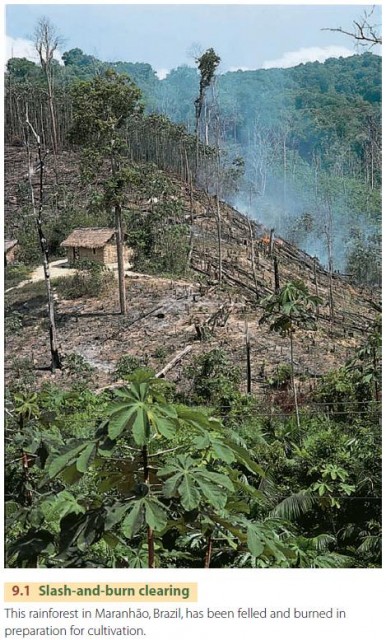Exploitation of the Low-Latitude Rainforest Ecosystem
Many of the world's equatorial and tropical regions are home to the rainforest ecosystem. This ecosystem is perhaps the most diverse on Earth, possessing more species of plants and animals than any other. Very large tracts of rainforest still exist in South America, south Asia, and some parts of Africa. Ecologists regard this ecosystem as a genetic reservoir of many species of plants and animals. But as human populations expand and the quest for agricultural land continues, low-latitude rainforests are being threatened by clearing, logging, cultivation of cash crops, and animal grazing.
In the past, low-latitude rainforests were farmed by native peoples using the slash-and-burn method—cutting down all the vegetation in a small area, then burning it (Figure 9.1). In a rainforest ecosystem, most of the nutrients are held within living plants rather than in the soil. Burning the vegetation on the site releases the trapped nutrients, returning a portion of them to the soil where they are available to growing crops.

The supply of nutrients derived from the original vegetation cover is small, however, and the harvesting of crops rapidly depletes the nutrients. After a few seasons of cultivation, the old field is abandoned, and a new field is cleared. Nearby rainforest plants soon reestablish their hold on the abandoned area. Eventually, the rainforest returns to its original state.
In contrast, modern intensive agriculture uses large areas of land and is not compatible with the rainforest ecosystem. When large areas are abandoned, seed sources are so far away that the original forest species cannot take hold. Instead, secondary species dominate, often accompanied by good invaders from other vegetation types. Once these invaders enter an area, they tend to stay, and their dominance is permanent, at least on the human time scale. The rainforest ecosystem is thus a resource that, once cleared, will never return in quite the same way. The loss of low-latitude rainforest will result in the disappearance of thousands of species of organisms from the rainforest environment—a loss of millions of years of evolution, together with the destruction of the most complex ecosystem on Earth.
In Amazonia, transformation of large areas of rainforest into agricultural land uses heavy machinery to carve out major highways and innumerable secondary roads and trails. Large fields for cattle pasture or commercial crops are created by cutting, bulldozing, clearing, and burning the vegetation. In some regions, the great broad-leaved rainforest trees are removed for commercial lumber.
According to a recent report issued by the United Nations Food and Agriculture Organization, about 0.6 percent of the world's rainforest is lost annually by conversion to other uses. More rainforest land, 2.2 million hectares (about 8500 mi2), is lost annually in Asia than in Latin America and the Caribbean, where 1.9 million hectares (about 7300 mi2) are converted every year. Africa's loss of rainforest was estimated at about 470,000 hectares per year (1800 mi2). Among individual countries, Brazil and Indonesia are the loss leaders, accounting for nearly half of the rainforest area converted to other uses. These values do not include even larger losses of moist deciduous forests in these regions. Deforestation in low-latitude dry deciduous forests and hill and montane forests is also very serious.
Although deforestation rates are very rapid in some regions, many nations are now working to reduce the rate of loss of rainforest environment. However, because the rainforest can provide agricultural land, minerals, and timber, the pressure to allow deforestation continues.